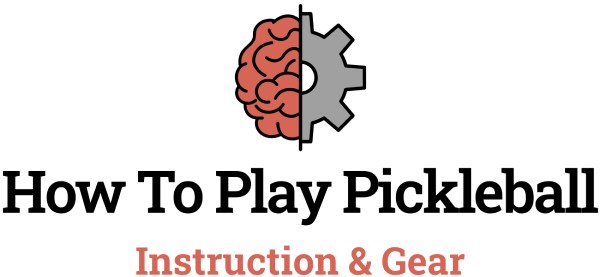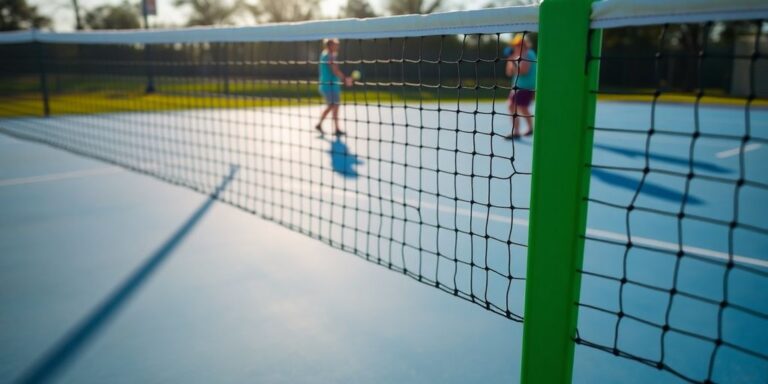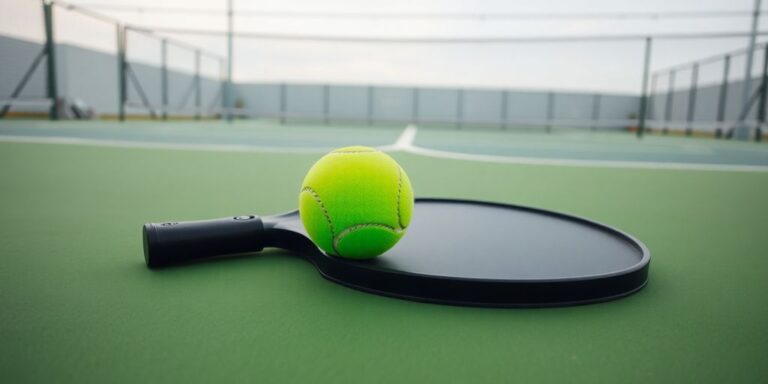Pickleball might seem like a new craze, but it actually has roots going back to 1965. What started as a simple backyard game on Bainbridge Island, Washington, has grown into one of the fastest-growing sports in the U.S. Today, it’s played by millions of people of all ages, and its quirky name still sparks debates. Let’s explore how this fun, accessible game came to be and why it’s taken the nation by storm.
Key Takeaways
- Pickleball was invented in 1965 by Joel Pritchard, Bill Bell, and Barney McCallum on Bainbridge Island, Washington.
- The sport began as a family activity using makeshift equipment like ping-pong paddles and a perforated plastic ball.
- The name ‘pickleball’ has two debated origins: a dog named Pickles or a ‘pickle boat’ in crew racing.
- Pickleball’s popularity surged during the COVID-19 pandemic as people sought socially distant activities.
- Today, pickleball is played by millions and continues to grow, appealing to players of all ages and skill levels.
The Birth of Pickleball in 1965
How Joel Pritchard and Bill Bell Created the Game
It was the summer of 1965, and Joel Pritchard, a congressman, and his friend Bill Bell were spending time at Pritchard’s summer home on Bainbridge Island, Washington. Their kids were restless and bored, and the two men decided to create a new activity to keep them entertained. Using an old badminton court, some table tennis paddles, and a perforated plastic ball, they improvised a game that would eventually become pickleball. What started as a simple backyard solution for bored kids turned into a sport played by millions.
The Role of Bainbridge Island in Pickleball’s Origin
Bainbridge Island wasn’t just the setting—it was the birthplace of the sport. The island’s laid-back atmosphere and sense of community played a huge role in pickleball’s early development. Families and neighbors gathered to play, and the game quickly spread among the local community. Over time, this small island became known as the cradle of pickleball, where a casual pastime evolved into a structured sport.
The First Pickleball Game: A Family Affair
The first game of pickleball was truly a family event. Pritchard and Bell’s children were the initial players, testing out the rules and figuring out how to make the game fun and accessible. The early days were filled with experimentation—adjusting the height of the net, refining the paddles, and tweaking the rules to make it enjoyable for all ages. This family-first approach is still at the heart of pickleball today, making it one of the most inclusive sports out there.
"From its humble beginnings on a backyard badminton court, pickleball has grown into a sport that connects people of all ages and backgrounds."
The Evolution of Pickleball Equipment

From Ping-Pong Paddles to Composite Designs
When pickleball started back in 1965, players used whatever they had lying around—usually ping-pong paddles. These wooden paddles were basic, heavy, and not exactly ideal for gameplay. Fast forward to today, and we’ve got composite paddles made from materials like graphite and fiberglass. These modern paddles are lighter, stronger, and give players more control over their shots. The evolution of paddles reflects the growing sophistication of the sport and the demands of its players.
The Development of Specialized Pickleballs
In the early days, any wiffle ball would do, but that didn’t last. The problem? Wind would send those lightweight balls flying off course. This led to the creation of specialized pickleballs with a thicker design and smaller holes. These balls are now tailored for either indoor or outdoor play, ensuring consistent performance no matter where you’re playing.
- Indoor pickleballs: Softer, with larger holes for better control.
- Outdoor pickleballs: Harder and more durable, designed to handle wind and rougher surfaces.
How Equipment Changes Improved Gameplay
The shift from makeshift gear to purpose-built equipment has completely changed how pickleball is played.
- Paddles: Composite materials allow for better spin and precision.
- Balls: Specialized pickleballs reduce wind interference and improve bounce consistency.
- Nets: Standardized nets ensure fair play and uniformity across courts.
The evolution of pickleball equipment isn’t just about technology—it’s about making the game more accessible and enjoyable for players of all levels.
The Spread of Pickleball Across America
Pickleball’s Early Growth in Senior Communities
Pickleball found its first loyal fanbase among seniors. The sport’s low-impact nature made it a perfect fit for older adults seeking fun and fitness without risking joint strain. Snowbirds—retirees who migrate to warmer climates during winter—played a big role in spreading the game. They brought pickleball from Bainbridge Island to sunny states like Florida and Arizona, where it became a staple in retirement communities. These early adopters laid the groundwork for the sport’s expansion.
The Role of Pickle Ball, Inc. in Popularizing the Sport
In 1968, Joel Pritchard co-founded Pickle Ball, Inc., a company dedicated to producing pickleball equipment. By creating ready-to-play kits, they made it easy for people to set up games in their backyards or local parks. This accessibility was key to pickleball’s steady rise in popularity. Over time, these kits turned the sport into a household name, particularly in warmer regions of the U.S. Today, Pickle Ball, Inc.’s legacy lives on through its influence on the sport’s growth.
How the Pandemic Boosted Pickleball’s Popularity
The COVID-19 pandemic turned pickleball into a national obsession. As people searched for socially distant activities, the sport’s small court size and doubles format made it an ideal choice. Families and friends picked up paddles, and soon, pickleball courts were popping up everywhere. The pandemic didn’t just introduce the sport to new players—it created lifelong fans. This surge in popularity solidified pickleball’s status as America’s fastest-growing sport.
The Mystery Behind the Name ‘Pickleball’

Was It Named After a Dog Named Pickles?
One of the most popular and endearing stories claims that pickleball got its name from the Pritchard family’s dog, Pickles. According to this tale, Pickles had a habit of chasing the ball during games, leading the family to nickname the sport "Pickle’s ball." However, there’s a catch: this dog didn’t even exist when the game was first invented in 1965. Pickles joined the family years later, in 1968. So while it’s a charming story, it doesn’t quite hold up to scrutiny.
The ‘Pickle Boat’ Theory Explained
The more historically accurate explanation comes from Joan Pritchard, Joel Pritchard’s wife. She was inspired by the term "pickle boat," which refers to a rowing crew made up of leftover oarsmen from other teams. Joan thought the name was fitting since pickleball was created using bits and pieces from other sports—badminton, table tennis, and tennis. This theory ties the name to the sport’s hybrid nature, making it a clever and meaningful choice.
Why the Name Still Sparks Debate
Even today, the origin of pickleball’s name is a hot topic among players and fans. Some love the whimsical dog story, while others champion the rowing connection. The debate adds a layer of charm to the sport, sparking conversations on and off the court. Regardless of which story you believe, the quirky name is part of what makes pickleball so memorable and unique.
Whether it’s the dog or the boat, one thing is clear: the name "pickleball" captures the playful and inventive spirit of this beloved sport.
Pickleball’s Journey to Becoming a Mainstream Sport
The First Pickleball Tournament in 1976
The year 1976 marked a pivotal moment for pickleball when the first official tournament was held in Tukwila, Washington. This event was a humble beginning, attracting mainly tennis players who were curious about this new sport. It wasn’t a glamorous affair—players used wooden paddles, and the rules were still being refined. But this tournament laid the groundwork for what would become a competitive and organized sport.
The Formation of the USA Pickleball Association
In 1984, the USA Pickleball Association (USAPA) was established to standardize rules and promote the sport across the nation. This organization played a major role in turning pickleball from a casual backyard game into a recognized sport. They created official guidelines, organized tournaments, and worked tirelessly to grow the pickleball community. Thanks to their efforts, pickleball began to appear in recreation centers, schools, and parks nationwide.
Televised Events and Media Coverage
The rise of televised pickleball events has been a game-changer. Networks like CBS have started broadcasting major tournaments, including the USAPA National Championships and the PPA Tour. This exposure has introduced millions of viewers to the sport, sparking interest and participation. Media coverage has also highlighted the sport’s inclusivity, showing that pickleball truly is a game for all ages and skill levels. As more people see professionals competing on TV, the sport’s reputation as a serious, competitive activity continues to grow.
Pickleball’s journey from a backyard pastime to a mainstream sport is a testament to its universal appeal and the dedication of its community. What started as a family activity has evolved into a global phenomenon, uniting players of all backgrounds.
Why Pickleball Appeals to All Ages
The Accessibility of Pickleball Courts
One of the biggest draws of pickleball is how easy it is to find a place to play. Courts are popping up everywhere—parks, community centers, even schools. Unlike some sports that require large fields or expensive facilities, pickleball courts are compact and affordable to build. This accessibility has made it possible for people of all ages to join in the fun.
Here’s a quick look at why the courts are so inviting:
- They’re smaller than tennis courts, making them easier to navigate for kids and seniors.
- Many communities convert unused spaces, like old basketball courts, into pickleball courts.
- Public courts are often free or very inexpensive to use.
How Simple Rules Attract Beginners
Pickleball is beginner-friendly because the rules are straightforward and easy to grasp. You don’t need to memorize a complicated rulebook to start playing. For example:
- The ball must stay within the court boundaries—simple, right?
- Serves are underhand, making them easier for everyone to execute.
- You can play doubles or singles, so no need to round up a big group.
This simplicity makes it appealing for first-time players, whether they’re kids trying a new sport or older adults looking for a low-pressure activity.
The Social and Strategic Elements of the Game
Pickleball isn’t just about hitting a ball back and forth; it’s also a social experience. The doubles format encourages teamwork and communication, while the pace of the game allows for lighthearted banter between players. Plus, there’s a strategic side to pickleball that keeps it interesting for seasoned athletes. Players often find themselves planning clever shots and anticipating their opponent’s moves.
"Pickleball combines the physical benefits of exercise with the mental stimulation of strategy, making it a hit with everyone from kids to retirees."
In short, the sport’s mix of accessibility, simplicity, and social interaction explains why it’s becoming a favorite pastime for people of all ages. Whether you’re looking for a workout, a bit of competition, or just a fun way to spend time with others, pickleball has something for everyone.
Pickleball is a sport that everyone can enjoy, no matter their age. It’s easy to learn and offers a fun way to stay active. Families can play together, making it a great choice for bonding time. If you want to discover more about how pickleball can bring joy to your life, visit our website today!
Conclusion
Pickleball’s journey from a backyard pastime in 1965 to a nationwide phenomenon is nothing short of remarkable. What started as a simple game to entertain bored kids has grown into a sport loved by millions across all ages. Whether it’s the quirky name, the easy-to-learn rules, or the sense of community it fosters, pickleball has carved out a special place in America’s heart. As it continues to expand, who knows? Maybe one day we’ll see it on the Olympic stage. For now, it’s clear that pickleball isn’t just a trend—it’s here to stay.
Frequently Asked Questions
Who invented pickleball and when?
Pickleball was invented in 1965 by Joel Pritchard, Bill Bell, and Barney McCallum on Bainbridge Island, Washington.
Why is it called pickleball?
The name ‘pickleball’ has two possible origins: it might be named after Joel Pritchard’s dog, Pickles, or it could come from the term ‘pickle boat,’ which refers to a crew made up of leftover rowers.
What equipment was first used to play pickleball?
In the early days, players used table tennis paddles and a perforated plastic ball, often referred to as a wiffle ball.
How has pickleball grown in popularity?
Pickleball started as a backyard game and gained momentum in senior communities. Its popularity skyrocketed during the pandemic as people sought socially distant activities.
What makes pickleball appealing to all age groups?
Pickleball is easy to learn, has simple rules, and combines fun with strategic gameplay. Its smaller court size and slower pace make it accessible to players of all ages and skill levels.
When was the first pickleball tournament held?
The first official pickleball tournament took place in 1976, marking a significant step in the sport’s development.




